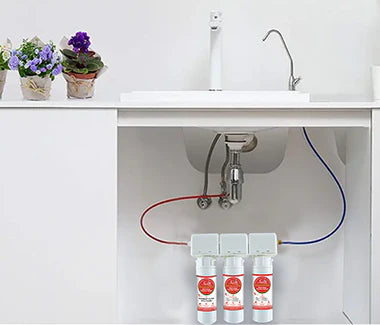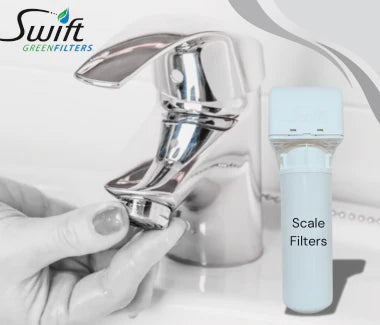What are the diseases caused by drinking contaminated water?
Posted by Swift Green Filters on

Living things require accessibility to pure water. Unluckily, not everybody has the luxury of having access to clean, secure water. Diseases caused by drinking contaminated water represent a serious risk to the general population worldwide, especially in developing nations. The many illnesses that can result from drinking water that has been contaminated will be covered in detail in this blog, along with suggestions for safeguarding your family's health.
What is Contaminated Water?
Dangerous bacteria, chemicals, or toxins found in polluted water can cause a variety of ailments. Personal waste, runoff from farms, and industrial waste are common causes of contaminated water. Poor sanitation raises the risk of diseases caused by drinking contaminated water in many nations with little development. Contaminated water, either from chemicals, untreated wastewater, or pollutants like mercury, lead, has a disastrous impact on the well-being of individuals.
Common Diseases Caused by Drinking Contaminated Water
1. Cholera
One of the most well-known diseases caused by drinking contaminated water is cholera, which is caused by the bacterium Vibrio cholerae. This disease results in severe diarrhea and dehydration, which can be fatal if not treated promptly. Cholera outbreaks are common in regions with poor sanitation and contaminated water sources.
Symptoms:
- Severe watery diarrhea
- Dehydration
- Nausea and vomiting
Prevention:
- Use clean water for drinking and cooking.
- Ensure proper sanitation practices.
Shigellosis, also known as dysentery, is caused by the bacteria Shigella, which can contaminate water and food. It spreads easily through contaminated water and poor hygiene. Dysentery leads to diarrhea, fever, and abdominal pain. In severe cases, it can result in life-threatening dehydration.
Symptoms:
- Diarrhea with blood or mucus
- Stomach pain
- Fever
Prevention:
- Ensure access to safe, clean drinking water.
- Practice proper hand hygiene.
Hepatitis A is a viral infection of the liver caused by the Hepatitis A virus (HAV). This virus spreads through the consumption of contaminated water and food, especially in regions with poor water treatment infrastructure. Hepatitis A can lead to jaundice, fatigue, and abdominal pain.
Symptoms:
- Jaundice (yellowing of the skin and eyes)
- Fatigue
- Nausea and abdominal pain
Prevention:
- Vaccination
- Avoiding consumption of potentially contaminated water and food.
When contaminated water is consumed, E. coli bacteria can cause serious gastrointestinal diseases. While most strains of E. coli are harmless, some can cause food poisoning, diarrhea, and stomach pains.
Symptoms:
- Stomach cramps
- Diarrhea (sometimes bloody)
- Vomiting
Prevention:
- Ensure water is properly filtered or boiled before consumption.
- Practice proper food and water safety.
The typhoid fever is triggered by the bacteria known as Salmonella typhi. This illness spreads by contamination of water or meals and, if left untreated, causes a persistent fever, gastrointestinal discomfort, and other consequences. Typhoid is particularly prevalent in places with insufficient water and wastewater wastewater treatment facilities.
Symptoms:
- High fever
- Stomach pain
- Weakness
Prevention:
- Vaccination
- Consuming clean water and properly cooked food.
Giardiasis is an infection caused by the parasite Giardia lamblia. The parasite enters the body through contaminated water and affects the intestines, causing diarrhea, bloating, and gas. It is a common issue in areas with inadequate water filtration.
Symptoms:
- Diarrhea
- Gas and bloating
- Stomach cramps
Prevention:
- Use water filters to remove parasites from drinking water.
- Boil water from untreated sources before consumption.
The parasite Cryptosporidium, which is frequently seen in tainted water supplies, is the cause of cryptosporidiosis. Dehydration and watery diarrhea are the main symptoms of this illness, which mostly affects those with compromised immune systems.
Symptoms:
- Watery diarrhea
- Stomach cramps
- Nausea
Prevention:
- Avoid drinking untreated water.
- Ensure proper sanitation and use of water filters.
As opposed to other waterborne illnesses, Legionnaires' disease is contracted by breathing in water droplets tainted with the Legionella bacteria. This illness can be fatal for the elderly and others with compromised immune systems, and it causes severe symptoms similar to pneumonia.
Symptoms:
- Fever
- Cough
- Shortness of breath
Prevention:
- Proper maintenance of water systems, especially hot water tanks and cooling systems.
- Using water filters designed to remove bacteria from water systems.
Symptoms of Waterborne Diseases
Without the right testing, it can be difficult to differentiate between the many diseases caused by drinking contaminated water because they all have similar symptoms. Typical symptoms consist of:
- Diarrhea
- Vomiting
- Abdominal cramps
- Dehydration
- Fever
- Fatigue
Dehydration from diarrhea can turn fatal for illnesses like cholera and typhoid if it is not treated right away. Lead and other chemical pollutants may not show symptoms right away, but over time, they can cause long-term health concerns, including harm to important organs and developmental delays in children.
How to Prevent Diseases Caused by Drinking Contaminated Water
The best way to avoid diseases caused by drinking contaminated water is to ensure that your water is clean and safe for consumption. Here are a few preventive measures you can take:
- Use Water Filters: One of the best ways to guarantee quality water for consumption is to set up water filters that are approved to reduce impurities like viruses, microorganisms, lead, and other dangerous compounds. Filters like Swift Green Filters have been shown to reduce over 300 pollutants, including lead, chlorine, and harmful bacteria. They’re IAPMO certified to meet NSF/ANSI 42, 53, and 401 Standards, ensuring high performance and safety, making them an excellent choice for clean and safe drinking water.
- Boil Water: In situations where you’re unsure of the water’s safety, boiling it can kill most bacteria and viruses. Boiled water is a simple and cost-effective way to reduce the risk of diseases caused by drinking contaminated water.
- Practice Good Hygiene: Washing your hands with soap and clean water before and after touching food and using the bathroom can help to reduce the transmission of illnesses caused by water.
- Proper Sanitation: Adequate sanitation systems help prevent contamination of drinking water with harmful bacteria and viruses from human waste. Communities with poor sanitation are at greater risk of waterborne diseases.
- Avoid Untrusted Water Sources: Drinking water that comes from lakes, rivers, or uncontrolled wells is generally not recommended because they are frequently polluted. When traveling to locations with dangerous water sources, always drink bottled or purified water.
Conclusion: Take Action to Secure Safe Water
Although several individuals continue to suffer from diseases caused by drinking contaminated water, having access to purified water is a fundamental human right. We can drastically lower the prevalence of these preventable diseases by being cautious and adopting measures like utilizing water filters, maintaining excellent hygiene, and pushing for better sanitation. Make sure you have access to pure, secure water to consume to safeguard your wellness and the health of those you love.
Shop By Category
Swift Green Filters offers wide variety of filtration product

This multistage filter is an excellent alternative for water purification.
Swift Green Filters is the company's own brand that specialized in multistage filters.
In other words, it is unconnected to the other brands, yet it meets your filtering requirements.
Swift is not responsible for damage caused by installation or equipment errors. Max liability is two times the cost of the product.

We Have
Awesome Discounts
Subscribe to our newsletter to get discounts.










